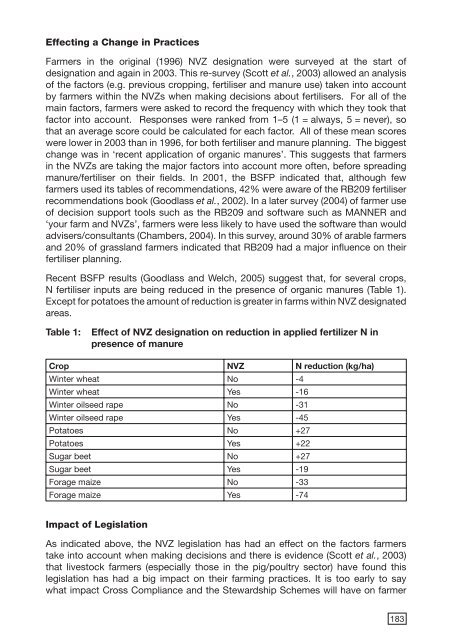Download as a PDF - CiteSeerX
Download as a PDF - CiteSeerX
Download as a PDF - CiteSeerX
You also want an ePaper? Increase the reach of your titles
YUMPU automatically turns print PDFs into web optimized ePapers that Google loves.
Effecting a Change in Practices<br />
Farmers in the original (1996) NVZ designation were surveyed at the start of<br />
designation and again in 2003. This re-survey (Scott et al., 2003) allowed an analysis<br />
of the factors (e.g. previous cropping, fertiliser and manure use) taken into account<br />
by farmers within the NVZs when making decisions about fertilisers. For all of the<br />
main factors, farmers were <strong>as</strong>ked to record the frequency with which they took that<br />
factor into account. Responses were ranked from 1–5 (1 = always, 5 = never), so<br />
that an average score could be calculated for each factor. All of these mean scores<br />
were lower in 2003 than in 1996, for both fertiliser and manure planning. The biggest<br />
change w<strong>as</strong> in ‘recent application of organic manures’. This suggests that farmers<br />
in the NVZs are taking the major factors into account more often, before spreading<br />
manure/fertiliser on their fields. In 2001, the BSFP indicated that, although few<br />
farmers used its tables of recommendations, 42% were aware of the RB209 fertiliser<br />
recommendations book (Goodl<strong>as</strong>s et al., 2002). In a later survey (2004) of farmer use<br />
of decision support tools such <strong>as</strong> the RB209 and software such <strong>as</strong> MANNER and<br />
‘your farm and NVZs’, farmers were less likely to have used the software than would<br />
advisers/consultants (Chambers, 2004). In this survey, around 30% of arable farmers<br />
and 20% of gr<strong>as</strong>sland farmers indicated that RB209 had a major influence on their<br />
fertiliser planning.<br />
Recent BSFP results (Goodl<strong>as</strong>s and Welch, 2005) suggest that, for several crops,<br />
N fertiliser inputs are being reduced in the presence of organic manures (Table 1).<br />
Except for potatoes the amount of reduction is greater in farms within NVZ designated<br />
are<strong>as</strong>.<br />
Table 1:<br />
Effect of NVZ designation on reduction in applied fertilizer N in<br />
presence of manure<br />
Crop NVZ N reduction (kg/ha)<br />
Winter wheat No -4<br />
Winter wheat Yes -16<br />
Winter oilseed rape No -31<br />
Winter oilseed rape Yes -45<br />
Potatoes No +27<br />
Potatoes Yes +22<br />
Sugar beet No +27<br />
Sugar beet Yes -19<br />
Forage maize No -33<br />
Forage maize Yes -74<br />
Impact of Legislation<br />
As indicated above, the NVZ legislation h<strong>as</strong> had an effect on the factors farmers<br />
take into account when making decisions and there is evidence (Scott et al., 2003)<br />
that livestock farmers (especially those in the pig/poultry sector) have found this<br />
legislation h<strong>as</strong> had a big impact on their farming practices. It is too early to say<br />
what impact Cross Compliance and the Stewardship Schemes will have on farmer<br />
183

















